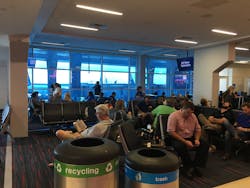When Dallas Fort Worth International Airport (DFW) leaders were looking at improvements to the facilities, one thing they noticed in Terminal A was a concessions issue at one of its restaurants.
The Twisted Root had issues with sun glare coming into its space, which in turn meant empty seats in the bar area when the sun would shine in.
But when the airport was looking at ways to enhance sustainability inside the terminal, they found something to address both the environment and flagging sales inside the restaurant — dynamic glass.
“This project gave us an opportunity to work on what we’re trying to do, which is change the image of sustainable, green buildings and green initiatives that they cost additional money,” said Robert Horton, vice president of environmental affairs at DFW. “We’re trying to change the way that people evaluate making decisions just on short-term paybacks alone.
“We wanted to use this to validate a theory that these solutions can drive economic value, can improve the experience for the passengers and have a whole host of benefits.”
DFW worked with View and installed dynamic glass at Twisted Root restaurant in Terminal A to test the results of how well the technology worked and how it influenced behavior. The 30-day trial in October showed an 80 percent spike in alcohol sales at the restaurant by creating a comfortable environment for patrons.
“It has been known that daylight drives retail activity, but I think this is the most concrete example of that,” said Brandon Tinianov, vice president of industry strategy for View Inc. “Certainly this is the first with direct correlation to dynamic glass.
A technology in waiting
Dynamic glass has been used frequently for years in office buildings and education facilities, but is relatively new in the airport realm. The windows sense light and adjust tint by time of day to increase or decrease sunlight in the terminal.
Tinianov said the glass can be adjusted down to allowing less than 0.5 percent of total light penetrating the window.
“In essence, its transition lenses for your building,” he said. “Unlike transition lenses, it doesn’t work solely on environmental factors. It’s actually controlled by an intelligent algorithm that sits on top of the system as a software interface.”
Installation of the glass included running wiring and low voltage connections to a power supply. A sensor was installed on the roof of the terminal to measure cloud conditions and override the sun’s angle on a cloudy day to optimize conditions.
Horton said DFW began exploring dynamic glass to maintain its carbon-neutral status. The best low-e glass and blinds still let in 30 percent of the solar heat. Dynamic glass offered a chance to tackle this heat and lower the strain on the airport’s HVAC system in the terminal.
“This opened up the possibility to solve some real problems and find singular solutions that have the biggest stakeholder impact,” he said.
A 2017 study showed office workers in buildings with dynamic glass were more productive and didn’t suffer as much with eye strain while reading electronic devices.
“While it’s hard to measure productivity while sitting at a gate, it’s pretty indicative that we may be addressing some of the comfort and health and wellness issues of passengers who are waiting for their plane to board,” Tinianov said.
San Francisco International Airport (SFO) installed dynamic glass in Terminal 1 and Tinianov said leaders there discovered there was ability to downsize the HVAC system within the terminal to reduce greenhouse gas benefits.
Tinianov said the dynamic glass was put in place at Twisted Root and at gate A28. They compared passenger experiences with travelers boarding at gate A25 with unmodified glass to see what impact the glass had via surveys.
The project showed the temperature reaching 90 degrees within the seating areas by the standard low-e glass. The seats by the dynamic glass were 10 to 15 degrees cooler, creating a more comfortable passenger experience.
The study shows at the dynamic glass gate saw passenger dwell time increase by 53 percent. Those passengers also had a 15 percent higher spend than those at the gate with regular glass.
Horton said they also discovered in the process the sun glare and solar heat extends even further into the building because of its positioning.
“The premise was to really study the impact from what we had learned in office environments and see if this applied to airports,” Tinianov said.
DFW is also a unique testing environment because of its design. With five semicircle-shaped terminals, Tinianov said you have every orientation of the sun shining in throughout the day. The facility uses quality glass, but also doesn’t utilize shades.
Influence passenger behavior
A survey of passengers showed having a view of the outside was the No. 1 factor in choosing where to sit in the terminal, Tinianov said, even outranking access to an outlet or bathroom.
“People love sitting where they have a view,” he said. “People love to have a view where they can see the planes landing or see the plane they’re boarding or planes taking off."
Cameras were installed at the gates to capture traveler behavior during the trial. There were also 500 surveys issued to passengers by a third party firm to get feedback from travelers on why they chose where to sit.
About 84 percent of passengers said they preferred sitting within 10 feet of the glass. Tinianov said the survey results not only confirm passengers put a high value of sitting somewhere with a view, but it also provides a path for future planning for airports, especially those growing as fast as DFW.
“You need to put more people into the same footprint of space, so that seating, the lost real estate at the perimeter of the building, you need to recapture that,” he said. “One, because you need it for increased passenger flow and two, it’s the most valuable property you have. It’s where the people are happiest and have the lowest stress levels.”
Horton said the study showed passengers were even more willing to sit closer to one another in the gate with the dynamic glass. One even took a selfie using the outside backdrop in the photo.
“People intuitively know that windows and views are a good thing, but they really want the validation to support that,” Tinianov said. “I also recognize that airports have a limited footprint. DFW is going to add 10 percent more passengers on an annual basis
“While this is a stand-alone product, it has the ability to positively impact multiple systems in the building,” he continued. “You really want to look at the way you can create some broader cost savings and design flexibilities for the terminal.”
Horton said DFW is exploring the opportunity to deploy the dynamic glass at a larger level at DFW.
“We definitely see the value and we hope to be exploring a strategy for implementing across our network,” he said. “Using these smarter ways of managing energy that goes into a building and reducing the demand so it requires less energy to operate is something we’re always going to chase.





